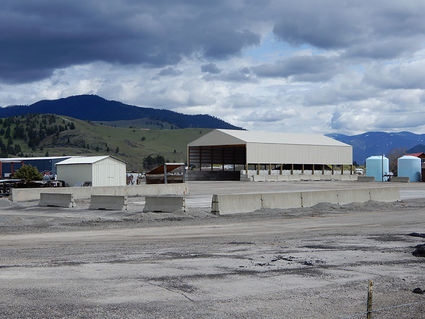Agency replaces tainted wells
Salt from MDT facility contaminated wells at nearby properties
May 17, 2018

Ledger Photo
UNDER COVER - At the Montana Department of Transporation maintenance site in Plains, road salt is now covered by a building, protecting it from rain and snow.
Each winter, the Montana Department of Transportation (MDT) uses salt and magnesium chloride as de-icing agents on state roadways. The substances are stored at facilities throughout the state. At six sites across the state, including two in Sanders County, MDT and the state Department of Environmental Quality (DEQ) are monitoring wells at neighboring properties due to salt contamination in groundwater.
Laura Alvey, an environmental science specialist with DEQ, said that in some cases, salt from a MDT maintenance facility on Lower Lynch Creek Road in Plains has leached into the ground and affected wells near the site. MDT and DEQ have been monitoring more than a dozen wells for contamination. Three of those wells were replaced by MDT this spring. Alvey said that each situation in the state is different. "In other locations, it was typically one to three wells affected, and most of the time the MDT well is the only one. Each situation is different." She said that wells are monitored quarterly, and more frequently if issues are found.
Plains is one of six MDT maintenance facility sites that the agencies are monitoring because of an issue with salt leaching into groundwater. The first site was Philipsburg in 2007.
Another site in Sanders County is in Noxon. Alvey said that the notice of violation letter for MDT was sent by DEQ in February 2013 for the Noxon site, and that streams and reservoirs were also tested there to make sure no salt is leaching into the water. "We didn't see any affects," Alvey said.
Alvey said that MDT reported the Plains issue in 2012. MDT initially tested the well at the state facility. "Once they found a problem, they looked at neighboring wells." She said that as MDT found wells with diminished water quality, the agency began delivering bottled water to those households.
MDT did not respond to a request for comment on the well contamination.
In Plains, MDT and DEQ have been monitoring more than a dozen wells. Alvey said that initially MDT installed a salt storage pad, as has been done at other sites where it was found that road salt was contaminating groundwater.
"Once you install a pad, typically that problem should start going away on its own through dilution," Alvey said. "At some sites it goes away pretty quickly. Because all these folks are on bottled water and the storage pad was in place, we monitor and see if that's going to take care of the problem."
She said that groundwater levels looked good in 2015, but in 2016 levels went up in a few wells. "It became clear that the salt storage pad wasn't taking care of this." Alvey also said that some residents began to complain of irrigation problems with landscaping. Then last fall, MDT installed a building over the salt and sand storage area. "The building keeps rain and snow and moisture off the salt, so there isn't a mechanism for salt to leach."
Alvey, with the DEQ groundwater remediation program, said that DEQ was concerned, and MDT replaced wells "for those folks whose water was severely impacted.
"With salt, this contamination is not a human health issue. It is a beneficial use issue. We don't have human health-based standards for these issues, so regulating this is different than if it's something that's making people sick." She said the issue people see with wells as in Plains is "more of a taste issue. Really unless someone is on a doctor-prescribed low-salt diet, the salt levels are just based on taste and ascetics, not on health."
Sanders County Sanitarian Shawn Sorenson addressed this issue at the county Board of Health meeting.
"It is a public health issue," Sorenson told county commissioners. "People need to know about this."
Stan Meredith lives along Lower Lynch Creek Road and first had his well tested in June of 2013. "Just after that, we started getting bottled water" from the state, Meredith said. "We noticed that the water tasted funny. It didn't taste salty, but it just didn't taste right." Meredith said that he and his wife Patsy also noticed that the water hardness had gone up. For instance, a white film would gather inside their dishwater. He also said that last year, they began noticing issues with their garden when they irrigate.
"What concerns me is it's not just our water that is affected," Meredith said. "They've caused our property values to go down." He said he is also concerned by the fact that a reading from his well in 2017 was higher than the initial test in 2013.
"I wish it would clear up on its own in my well," Meredith said. "It's already been since 2013." When he approached MDT last year, Meredith was told that only three wells would be replaced due to funding, and that his well was not one of them. "Why am I still on drinking water then?" Meredith questioned.
In monitoring wells, MDT tests a variety of factors. But the Administrative Rules of Montana classify groundwater as Class I through IV, with Class I being the highest quality. Alvey described Class I as suitable for residential domestic drinking water and any irrigation. She said that Class II can be used for residential and irrigation but is not as high quality. "When you get into Class III and Class IV, it's water that people wouldn't want to use at home," she said, adding that a number of the wells monitored in Plains have remained Class I.
Alvey said the wells that were replaced by MDT tested as Class III. She noted that the salt-impacted wells were "pretty shallow, at 40 to 60 feet deep. The new wells are 250 to 280 feet deep, from a different aquifer." DEQ will require monitoring of the shallow wells until the groundwater cleans up and returns to previous standards, Alvey said. "That could be years. At some point they may go to monitoring less frequently, but they will still be providing bottled water to folks whose water hasn't gotten down to Class I." Alvey also said that the shallow wells will be used as monitoring wells. "Eventually, in theory, once that salt flushes through the system those shallow wells could be used again." She also said that DEQ has asked MDT to evaluate whether any additional wells need to be replaced.





Reader Comments(0)